|
|
|
 |

 |
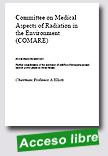 |
Further consideration of the incidence of childhood leukaemia around nuclear power plants in Great Britain
Committee on Medical Aspects of Radiation in the Environment (COMARE)/Health Protection Agency (UK), May 2011, 142 p.
The aim of this report is to undertake a further review of the incidence of childhood leukaemia in the vicinity of nuclear power plants (NPPs) in Great Britain, with particular reference to recent publications, including the German Kinderkrebs in der Umgebung von Kernkraftwerken (KiKK) study and studies from |
other countries (eg France and Finland), and in relation to the conclusions in the tenth and eleventh COMARE reports (COMARE, 2005, 2006). This review considers Great Britain (England, Scotland and Wales) and not the UK, since no NPPs are present in Northern Ireland.
In this report, COMARE presents a new geographical data analysis on the incidence of leukaemia in children under 5 years of age, living in the vicinity of NPPs, using cancer registration data currently available for Great Britain. The report has also characterised the pathology of the cases of childhood leukaemia and non-Hodgkin lymphoma (NHL) living near NPPs and compared them with matched cases from individuals not resident near NPPs.
The report investigates additional factors, which have not been considered in previous COMARE reports and which may contribute to variation in the results from different countries. It describes the cancer registries of several countries in Europe. It also describes the types of reactor present in selected European countries, considers the radioactive discharges from the NPPs of these countries and the consequent assessed radiation doses to the general population.
Extraído de:
http://www.comare.org.uk/press_releases/documents/COMARE14report.pdf
|
 |
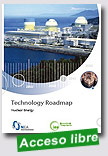 |
Nuclear Energy Technology Roadmap
Nuclear Energy Agency(NEA)/IAEA, September 2010, 49 p.
This roadmap outlines a set of quantitative measures and qualitative actions that define one global pathway for nuclear power deployment to 2050. It takes as a starting point the IEA Energy Technology Perspectives (ETP) BLUE Map scenario, which describes how energy technologies may be transformed by 2050 to achieve the global goal of reducing annual CO2 emissions to half that of 2005 levels. The model is a bottom-up MARKAL model that uses cost optimisation to identify least-cost |
mixes of energy technologies and fuels to meet energy demand, given constraints such as the availability of natural resources. The ETP model is a global 15-region model that permits the analysis of fuel and technology choices throughout the energy system. The model’s detailed representation of technology options includes about 1 000 individual technologies. The model has been developed over a number of years and has been used in many analyses of the global energy sector. In addition, the ETP model was supplemented with detailed demand-side models for all major end-uses in the industry, buildings and transport sectors.
Extraído de:
http://www.oecd-nea.org/ndd/reports/2010/nea6962-nuclear-roadmap.pdf |
 |
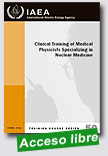 |
Clinical Training of Medical Physicists Specializing in Nuclear Medicine
IAEA, 2011, 278 p.
The application of radiation in human health, for both diagnosis and treatment of disease, is an important component of the work of the IAEA. The responsibility for the increasingly technical aspects of this work is undertaken by the medical physicist. To ensure good practice in this vital area, structured clinical training programmes are required to complement academic learning. This publication is intended to be a guide to the practical implementation of such a programme for nuclear medicine.
|
There is a general and growing awareness that radiation medicine is increasingly dependent on well trained medical physicists who are based in a clinical setting. However an analysis of the availability of medical physicists indicates a large shortfall of qualified and capable professionals. This is particularly evident in developing countries. While strategies to increase educational opportunities are critical to such countries, the need for guidance on structured clinical training was recognized by the members of the Regional Cooperative Agreement for Research, Development and Training related to Nuclear Science and Technology (RCA) for
the Asia–Pacific region. Consequently, a technical cooperation regional project (RAS6038) under the RCA programme was formulated to address this need in this region by developing suitable material and establishing its viability.
Extraído de:
http://www-pub.iaea.org/MTCD/publications/PDF/TCS-50_web.pdf
|
 |
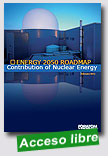 |
|
foreword. The report entitled, Energy 2050 Roadmap: Contribution of Nuclear Energy, features critical analyses carried out by the Paul Scherrer Institute, the Swiss research centre, of different scenarios drawn out from studies published by international organisations like the International Energy Agency (IEA), the OECD/Nuclear Energy Agency, Eurelectic, the EC and the World Energy Outlook. The main conclusion of the report is that if the EU wants to achieve its security of supply, competitiveness and climate change goals, the share of nuclear (around one third) in the EU’s total electricity generation should be at least maintained. The report also includes recommendations to EU decision-makers, national authorities and the nuclear industry. If the right conditions are met (political support and a sustained focus on security of supply, competitiveness and climate change), nuclear could provide the EU with up to 160-170 GW of electricity in 2050.
While the EU and the rest of the world are drawing the lessons from the Fukushima events and improving the level of safety at nuclear plants accordingly, it is important to keep in mind the benefits of nuclear power, which plays an important role in EU’s current and future energy mix
Extraído de:
http://www.foratom.org/e-bulletin-tout-1378/other-articles-tout-1385/832-nuclear-to-remain-a-significant-part-of-eus-energy-mix-by-2050.html
|
 |
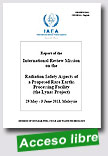 |
Radiation Safety Aspects of a Proposed Rare Earths Processing Facility (the Lynas Project)
IAEA, 2011, 57 p.
On 3 May 2011, a high-level delegation representing the Malaysian government met IAEA Director General Yukiya Amano to request the Agency to organize an independent panel of international experts to review the radiation health and safety aspects of the Lynas Project.
Support for the international expert mission to review the Lynas Project was provided through the IAEA Technical Cooperation Programme, and focused on the project's compliance with |
relevant international Safety Standards and Good Practices, and as well as providing an independent expert opinion on the radiological safety aspects of the Lynas Project.
The members of the independent, international expert team are knowledgeable in IAEA Safety Standards and have broad professional experience in their respective disciplines, in particular those radiological safety aspects related to rare earth processing and Naturally Occurring Radioactive Materials, as well as regulatory control, radiation protection for workers, the public and the environment, in addition to expertise in safety assessments, waste management, environmental monitoring and surveillance, decommissioning and environmental remediation and transport safety.
Extraído de:
http://www.iaea.org/newscenter/news/2011/malaysialynasproject.html |
 |
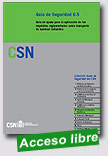 |
Guía de ayuda para la aplicación de los requisitos reglamentarios sobre transporte de material radiactivo
Consejo de Seguridad Nuclear (CSN - ES), 2011, 220 p.
Esta guía de seguridad tiene por objeto facilitar a todos los usuarios del transporte de material radiactivo por carretera el acceso a los requisitos establecidos en la reglamentación de transporte de mercancías peligrosas.
Esta guía de seguridad se centra en el transporte de materiales radiactivos por carretera en los países contratantes del Acuerdo Europeo sobre Transporte Internacional de Mercancías |
Peligrosas por Carretera y aplica a los diseñadores y fabricantes de materiales radiactivos y de los embalajes utilizados para su transporte y a los expedidores, transportistas y receptores de bultos radiactivos.
No obstante, puede ser también útil para la determinación de aquellos requisitos en el transporte aéreo, marítimo y por ferrocarril que no estén directamente relacionados con el modo de transporte, tales como los relativos al diseño de bultos y a su preparación para el transporte, ya que en todos los casos provienen del Reglamento para el Transporte Seguro de Material Radiactivo del Organismo Internacional de Energía Atómica (OIEA).
Extraído de:
http://www.csn.es/images/stories/guia_de_seguridad_gs-06_05.pdf
|
 |
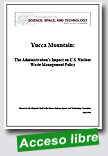
|
Yucca Mountain: The Administration’s Impact on U.S. Nuclear Waste Management Policy
Committe on Science, Space, and Technology (U.S. House of Representatives), June 2011, 203 p.
Today the Committee on Science, Space, and Technology released a report, prepared by the Majority Staff, outlining the findings from numerous document requests and official correspondence between Committee Members and Administration officials over the last two and half years, regarding the termination of Yucca Mountain as a nuclear waste |
repository. The report details the complete absence of scientific information and analysis used to support the shutdown decision, and reviews Administration actions in the context of promises and specific guidelines on scientific integrity, openness, and transparency set forth by President Obama and senior Administration officials.
Extraído de:
http://science.house.gov:80/press-release/committee-releases-report-outlining-administration’s-actions-undermine-us-nuclea
|
 |
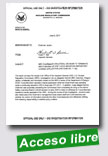 |
NRC Chairman Unilateral Decision to Terminate NRC´s Review of DOE Yucca Mountain Repository License Application
Office of the Inspector General (Nuclear Regulatory Commission - US), June 6, 2011, 46 p.
This report conveys the results of an Office of the Inspector General (OIG), U.S. Nuclear Regulatory Commission (NRC), investigation into the allegation that the NRC Chairman, Gregory Jaczko, unilaterally and improperly closed out the NRC´s review of the Department of Energy´s (DOE) Yucca Mountain Repository license application while the Government was operating under a continuing resolution (CR) in fiscal year (FY) 2011. In addition, it
|
was alleged that the Chairman was purposely preventing the Commission from completing its ruling on the Atomic Safety Licensing Board´s (ASLB) decision to deny DOE´s motion to withdraw its Yucca Mountain repository license application from NRC. During the course of this investigation, concerns were also raised about the Chairman´s management style toward staff and Commissioners and whether his control of information prevents the other Commissioners from effectively fulfilling their statutory responsibility to address policy matters.
OIG´s investigation examined whether the Chairman exceeded his authority in directing the NRC staff to close out the Yucca Mountain license application review during the CR period, the Commission´s adjucatory voting process, and the impact the Chairman´s management style has on the collegial functioning of the NRC Commission. The investigation findings appear in section III of this report.
Extraído de:
http://science.house.gov/sites/republicans.science.house.gov/files/061311_
IGREPORT.pdf |
 |
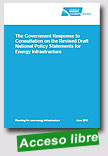 |
National Policy Statements for Energy InfrastructureDepartment of Energy & Climate Change (UK), June 2011, s. p.
The Government wants a planning system for major infrastructure which is rapid, predictable and accountable. Planning decisions should be taken within a clear policy framework, making these decisions as transparent as possible. The energy NPSs will be a blueprint for decision-making on individual applications for development consent for the relevant types of infrastructure. They will clearly set out Government’s policy in so far as it relates to planning applications for major energy infrastructure and will give investors the certainty they |
need to bring forward proposals to maintain security of supply and ensure progress towards decarbonisation.
Between 9th November 2009 and 22th February 2010, the previous Government consulted on the draft energy NPSs. Following a consideration of consultation responses and the outputs of the Parliamentary scrutiny process the Government decided to re-visit the draft energy NPSs and the Appraisals of Sustainability (AoSs) that underpin them. Given the changes that were made, the Government consulted on the revised draft NPSs and associated documents (including the AoSs) (referred to in this document as “revised drafts” to distinguish them from the drafts previously consulted on) from 18th October 2010 to 24th January 2011. The revised draft energy NPSs and associated documents are: Revised draft Overarching NPS for Energy (EN-1); Revised draft Fossil Fuel Electricity Generating Infrastructure NPS (EN-2); Revised draft Renewable Energy Infrastructure NPS (EN-3); Revised draft Gas Supply Infrastructure and Gas and Oil Pipelines NPS (EN-4); Revised draft Electricity Networks Infrastructure NPS (EN-5); Revised draft Nuclear Power Generation NPS (EN-6); Appraisals of Sustainability (AoSs) for the revised draft NPSs, EN-1 to 6 (AoS-1 to AoS-6); Habitats Regulations Assessments (HRAs) for the revised draft NPSs, EN-1 to 6; and Revised draft Impact Assessment for the revised draft NPSs, EN-1 to 6.
Extraído de:
http://www.decc.gov.uk/en/content/cms/meeting_energy/consents_
planning/nps_en_infra/nps_en_infra.aspx |
| |
|
|
|
|
|
|
|
|
|
|
